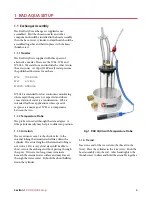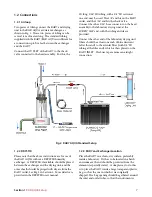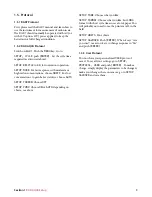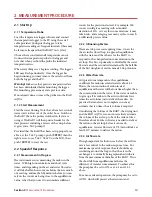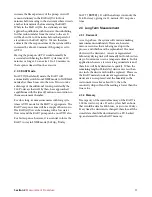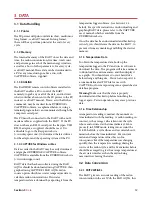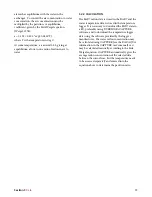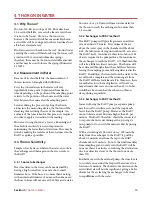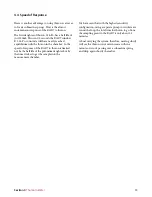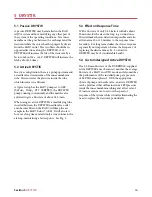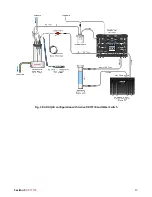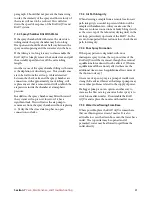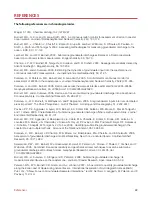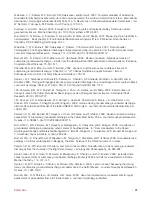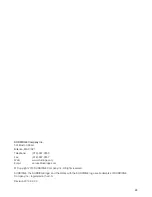
7 CARE, MAINTENANCE, AND TROUBLESHOOTING
7.1 Water Catastrophe
If water ever enters the RAD7, or if the RAD7 ever
goes swimming in the water, it will probably cease to
operate and immediate steps should be taken to
minimize the impact on the instrument.
Keep the RAD7 upright.
Th
is will prevent water from
touching the detector, which is close to the face plate
at the top of the dome. Put a piece of tubing on the
RAD7 outlet with the other end in a sink. Use the
RAD7 pump if it still works or, otherwise, an external
pump into the inlet, to blow air through the
instrument. When water ceases to be blown out of
the outlet, put desiccant upstream of the RAD7 to dry
out the air path. When the air path is fully dry (a
ft
er
dry air has been blown through it for approximately
one hour), remove the face plate from the case, empty
the water out of the case and blow dry the case and
the RAD7 electronics.
Once there is no visible water in or on the
instrument, it can be put in an oven at 50°C for a few
hours to dry out completely. Additionally, desiccated
air can be passed through the air path until the air
leaving the RAD7 drops below 10% RH. A
ft
er this
treatment further corrosion will be prevented, and
the RAD7 will boot once more and you can use the
internal RH sensor to measure how dry the air path
is. At this point the instrument should be returned to
DURRIDGE for service.
7.2 RAD7 Care
Water, particularly salt water, is hostile to electronic
instruments. Please keep the RAD7 in a relatively
clean and dry environment. One way is to enclose
the instrument in a large, transparent plastic bag, see
Section 1.2.3 above. Should it ever be seriously
splashed with salt water, please follow the
instructions in Section 7.1, above.
As a preventive measure, plastic cling wrap can be
placed over the RAD7 face plate and down the sides
of the RAD7. Push it down around the hose
connections, push the power and RS232 plugs into
their sockets, and push the lid onto its hinges.
Th
e
wrap will make the RAD7 almost watertight. If it
tears it can be easily replaced at any time.
Th
e instrument should, in any case, be returned every
year for recalibration.
It is useful to look at a cumulative spectrum
periodically.
Th
is may be obtained by having the
printer on and allowing the RAD7 to complete a run.
Th
e “Recycle” number may be set to the current cycle
number (
Setup, Recycle, NN
[ENTER]
). When
the RAD7 reaches the end of the current cycle it will
then print out the end of run summary including the
cumulative spectrum. Look to see that the peaks are
clean and in the normal position.
7.3 Exchanger Care
Th
e exchanger should be kept as clean as possible in
the circumstances. Sea water, if carrying any solid
matter, should be
fi
ltered.
Th
e spray nozzle should be
examined for build-up of deposits, and cleaned if
necessary.
7.4 Desiccant Regeneration
Please see the RAD7 manual for information on the
care and regeneration of the desiccant. Regenerated
desiccant, a
ft
er a few regenerations, loses most of its
indicating ability (due, we believe, to migration of the
cobalt chloride to the interior of the calcium sulphate
crystals). One way to ‘indicate’ the status is, every
time you re
fi
ll the laboratory drying unit with
regenerated desiccant, you
fi
rst add half an inch or so
of new, blue desiccant, out of the jar.
Th
is way, you
can always tell if the unit is still working, as the new
desiccant will only turn pink when the rest of the
desiccant, upstream, has become hydrated.
7.5 RAD AQUA Troubleshooting
7.5.1 Rising Water Level
Should water rise inside the exchanger there is a
danger that it may be sucked out into the desiccant
and RAD7.
Th
is may occur because of the water
supply having no dissolved gas and absorbing air
from the exchanger. To prevent this, a bleed
consisting of a long, small bore piece of tubing may
be connected, with a T-connector, to the return air
supply downstream of the check valve.
Rising foam, due to some forms of pollution in the
water, may also be treated with a bleed as in the above
Section 7
Care, Maintenance, and Troubleshooting
20

